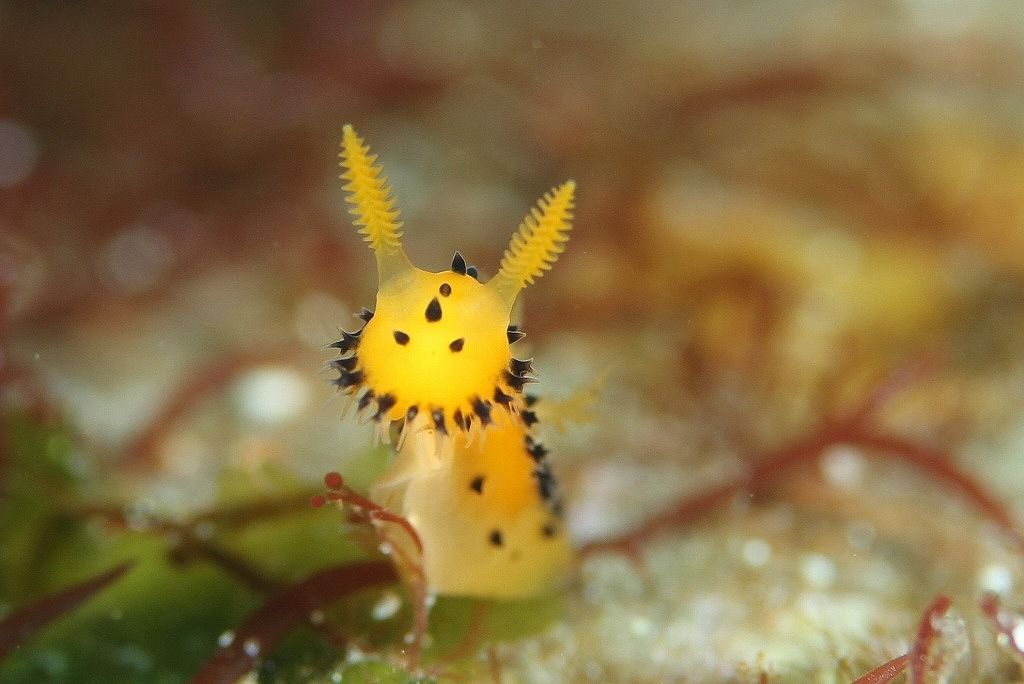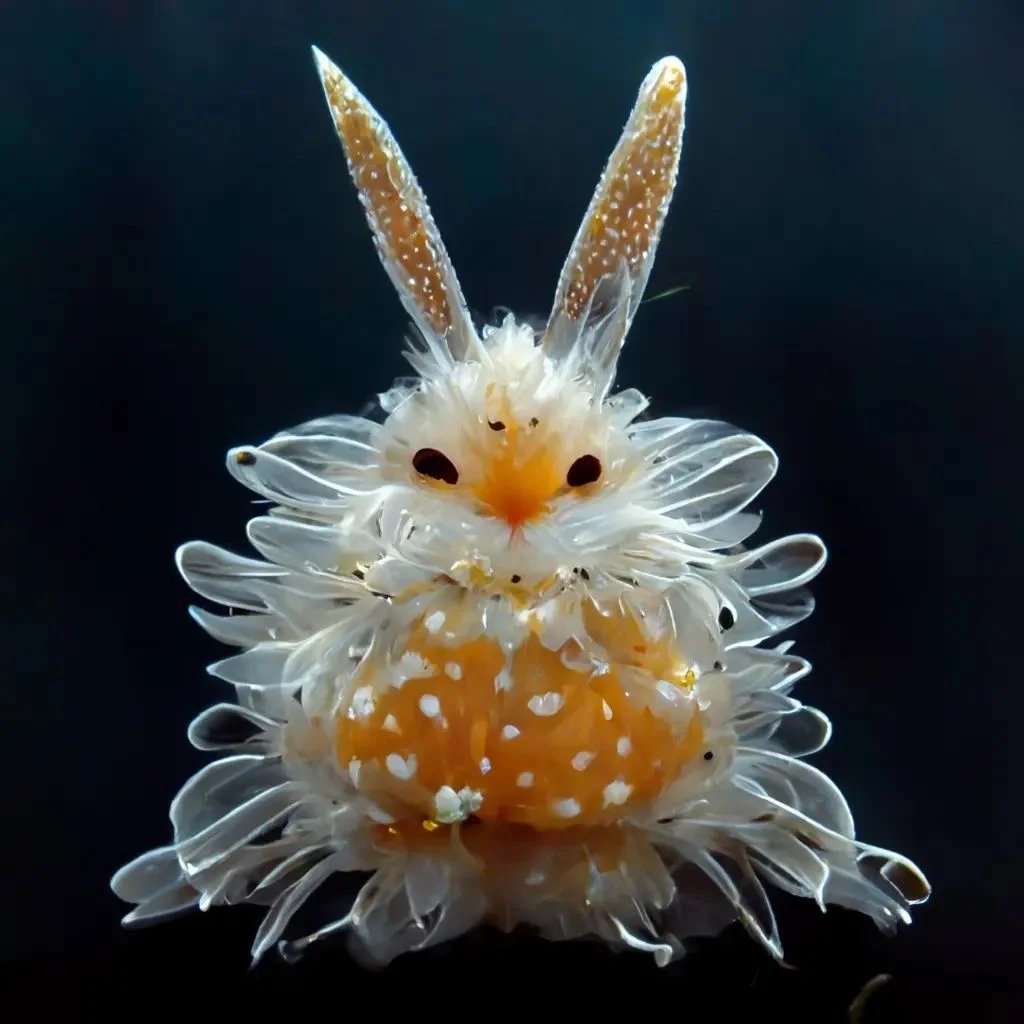Sea bunnies, known scientifically as Jorunna parva, are a type of nudibranch that has captured the fascination of marine enthusiasts worldwide. These adorable sea creatures are often referred to as “sea bunnies” due to their tiny, rabbit-like appearance, complete with what looks like fluffy ears and a cotton tail. Found primarily in the Indo-Pacific region, sea bunnies have become a popular subject in the realm of cute sea creatures.
Unique Characteristics of Sea Bunnies

Sea bunnies possess several unique features that make them stand out in the marine world. One of the most interesting aspects is their ability to absorb nematocysts (stinging cells) from the prey they consume, incorporating these cells into their own defensive mechanisms. This adaptation provides them with a potent means of protection against predators.
Here are some key characteristics of sea bunnies:
- Appearance: Sea bunnies are typically small, measuring about 1-2 centimeters in length. Their bodies are covered in a fine, velvety texture that resembles fur, giving them their distinctive “bunny” look.
- Coloration: They come in various colors, including white, yellow, and orange, often with spots or patterns that add to their charm.
- Habitat: Sea bunnies inhabit shallow, tropical waters and are often found clinging to rocks, coral, and seaweed.
- Diet: Their diet mainly consists of sponges, from which they absorb the nematocysts used for their defense.
For those interested in keeping sea bunnies in their marine aquariums, it’s essential to understand their specific needs and habitat requirements. For detailed information on how to care for these delightful creatures, visit our guide on sea bunny pet.
| Characteristic | Description |
|---|---|
| Size | 1-2 cm |
| Color | White, yellow, orange |
| Diet | Sponges |
| Habitat | Shallow, tropical waters |
Sea bunnies are not just cute but also fascinating in their adaptations and behaviors. Their ability to use nematocysts as a defense mechanism is shared among some other marine species, showcasing the diversity and complexity of marine life. For more fun facts about marine creatures, visit our page on sea bunny facts.
Fascinating Marine Creatures
Marine life is full of fascinating and diverse behaviors that captivate the interest of aquarium enthusiasts and marine biologists alike. From unique reproductive strategies to intriguing defense mechanisms, the ocean is home to a wide array of captivating creatures.
Diverse Marine Behaviors
Marine creatures exhibit a range of behaviors that are both fascinating and essential for their survival. Understanding these behaviors can provide insights into the complex lives of these underwater inhabitants.
- Damselfish Farming: Damselfish are known for growing algae gardens. They fiercely protect their territories, ensuring their algae crops thrive. This behavior showcases their role as diligent farmers in the marine ecosystem (Underwater Photography Guide).
- Hermaphroditic Fish: Many fish species, including clownfish, are hermaphrodites. They start their lives as females and switch to males when needed. This ability to change sex allows for flexible social structures and reproductive strategies.
- Barnacle Mating: Barnacles, which are related to crabs and lobsters, have a unique reproductive strategy. Fixed to the substrate, they use a long reproductive part to mate with distant partners, ensuring genetic diversity despite their immobility.
- Seahorse Birth: Male seahorses are famous for giving birth. They carry up to 2,000 babies in their brood pouch, a unique adaptation that allows for efficient reproduction (The Smiling Seahorse).
Intriguing Adaptations
Marine creatures have developed a variety of adaptations to survive and thrive in their underwater environments. These adaptations often involve unique physical and physiological traits.
- Nudibranch Defense: Nudibranchs, a group of soft-bodied marine gastropod mollusks, can absorb nematocysts (stinging cells) from the prey they eat. They then use these cells as part of their own defensive system, deterring predators (Underwater Photography Guide).
- Sea Cucumber Regeneration: Sea cucumbers can regenerate their intestines, even after ejecting them as a defense mechanism. This remarkable adaptation allows them to maintain essential functions for digestion and reproduction.
- Octopus Cardiovascular System: Octopuses have three hearts and blue blood. Their blood is copper-based, which is more efficient at transporting oxygen in cold, low-oxygen environments. This adaptation is crucial for their survival in various oceanic conditions (The Smiling Seahorse).
- Shark Skin: Sharks have skin covered with tiny teeth-like structures called dermal denticles, making their skin feel like sandpaper. These denticles reduce drag and turbulence, allowing sharks to swim efficiently.
- Bobtail Squid Camouflage: The bobtail squid is known for its adorable appearance and remarkable ability to camouflage. It uses bioluminescent bacteria to match the light filtering through the ocean, making it nearly invisible to predators.
These diverse behaviors and intriguing adaptations highlight the complexity and beauty of marine life. Whether you’re interested in sea bunnies or other cute sea creatures, understanding these fascinating aspects can enhance your appreciation for the underwater world. Explore more about sea bunny facts and their habitat to deepen your knowledge of these captivating creatures.
Endangered Sea Species

The ocean is home to many fascinating and adorable sea creatures. However, some of these species are facing threats that endanger their existence. Understanding these threats and the efforts to conserve these species is crucial for their survival.
Threatened Marine Life
Several marine species are currently endangered due to various factors such as habitat loss, pollution, and overfishing. Here are a few examples:
| Species | Main Threats |
|---|---|
| Smalltooth Sawfish | Habitat loss, bycatch |
| White Abalone | Overfishing |
| Green Turtle | Fishing gear, egg harvesting, habitat degradation, vessel strikes, pollution, climate change, disease |
| Vaquita | Gillnet entanglement |
| Whale Shark | Intentional fishing, bycatch, vessel strikes, oil and gas drilling |
Smalltooth Sawfish: Populations of smalltooth sawfish plummeted in the second half of the 20th century due to habitat loss and bycatch (Popular Mechanics).
White Abalone: Commercial and recreational overfishing along the California coast in the 1970s is a primary culprit of the white abalone’s decline (Popular Mechanics).
Green Turtle: The green turtle is subject to unintended capture in fishing gear, egg harvesting, nesting habitat degradation, vessel strikes, ocean pollution, warming climate, and disease (Popular Mechanics).
Vaquita: The only known threat to the vaquita is entanglement in fishing gear, particularly gillnets.
Whale Shark: The main threats to whale sharks are intentional fishing, bycatch in nets, vessel strikes, and local threats like oil and gas drilling (Popular Mechanics).
Conservation Efforts
To combat the threats faced by endangered sea species, various conservation efforts have been implemented worldwide. These efforts aim to protect these species and their habitats, ensuring their survival for future generations.
Marine Protected Areas (MPAs): Establishing MPAs helps to conserve marine ecosystems and protect endangered species. MPAs restrict human activities like fishing and drilling, allowing ecosystems to recover and thrive.
Fishing Regulations: Implementing stricter fishing regulations helps to reduce bycatch and overfishing. Measures such as seasonal fishing bans, gear restrictions, and catch limits are essential for the sustainability of marine life.
Habitat Restoration: Efforts to restore degraded marine habitats, like coral reefs and seagrass beds, are crucial for the survival of many endangered species. Restoration projects often involve replanting native vegetation, removing invasive species, and reducing pollution.
Public Awareness and Education: Raising awareness about endangered marine species and the importance of conservation can help garner public support for protective measures. Educational programs, campaigns, and community involvement are vital components of successful conservation efforts.
For those interested in marine aquariums, understanding the importance of conservation and the challenges faced by these cute sea creatures is essential. By supporting conservation efforts, individuals can contribute to the protection of species like the sea bunnies and ensure they continue to thrive in their natural habitats. For more information on sea bunnies, check out our articles on sea bunny facts, sea bunny habitat, and keeping sea bunnies as pets.
Cuteness in the Deep Sea
The deep sea is home to a variety of unique and adorable creatures that captivate the hearts of marine enthusiasts. From the playful bobtail squid to the whimsical Dumbo octopus, these deep-sea finds offer a glimpse into the enchanting world beneath the waves.
Adorable Deep-Sea Finds
The deep sea hides many charming creatures, each with its own unique appeal. Here are some of the most adorable deep-sea finds:
- Bobtail Squid: Known for its small size and cartoon-like appearance, the bobtail squid boasts big eyes that help it see in the dark (Quora). Its compact body and endearing features make it a favorite among marine enthusiasts.
- Dumbo Octopus: Named for its ear-like fins that resemble the Disney character Dumbo, this octopus is considered one of the cutest deep-sea creatures. Its graceful movements and charming appearance make it a delight to observe.
- Red Handfish: With its unusual, bulldog-like appearance, the Red Handfish stands out as a creature with strange cuteness. Unfortunately, it is critically endangered (Quora).
- Blobfish: Often misunderstood due to misleading images, the blobfish’s actual appearance in its natural habitat is considered cute. Underwater images reveal a different, more endearing look.
- Blue Dragon (Glaucus Atlanticus): This adorable deep-sea creature is found in the deep Indo-Pacific and Atlantic oceans. Its striking blue color and unique shape make it a personal favorite among many marine enthusiasts.
Uniquely Cute Sea Creatures
Beyond the deep-sea finds, there are many other uniquely cute sea creatures that capture the imagination:
- Sea Bunnies: These small, fluffy creatures are a type of sea slug known for their bunny-like appearance. They have white, fluffy bodies with black-tipped “ears” that resemble a rabbit. For more information, explore our section on sea bunnies.
- Leafy Sea Dragon: With its delicate, leaf-like appendages, the leafy sea dragon is both beautiful and unique. Its camouflage abilities make it a fascinating creature to observe.
- Pygmy Seahorse: Measuring less than an inch in length, the pygmy seahorse is one of the smallest and cutest marine creatures. Its tiny size and intricate patterns make it a marvel of the underwater world.
- Axolotl: Known as the “Mexican walking fish,” the axolotl is actually a type of salamander. Its cute, smiling face and feathery gills give it an endearing appearance.
- Nudibranchs: These colorful sea slugs come in a variety of shapes and sizes, each more enchanting than the last. Their vibrant colors and intricate patterns make them a favorite among divers and marine biologists.
| Creature | Description | Notable Feature |
|---|---|---|
| Bobtail Squid | Small size, big eyes | Cartoon-like appearance |
| Dumbo Octopus | Ear-like fins | Graceful movements |
| Red Handfish | Bulldog-like appearance | Critically endangered |
| Blobfish | Misunderstood appearance | Cute in natural habitat |
| Blue Dragon | Striking blue color | Unique shape |
These cute sea creatures, each with their own distinctive charm, contribute to the diverse and fascinating world of marine life. For those interested in adding unique marine species to their aquariums, these adorable creatures offer a delightful exploration into the depths of the ocean. For further reading on sea bunnies and their habitats, visit sea bunny facts and sea bunny habitat.
Keystone Species in the Ocean
Importance of Keystone Species
Keystone species are crucial to the health and stability of marine ecosystems. These species play a significant role in maintaining the structure and balance of their environments. By regulating the populations of other species, keystone species ensure biodiversity and the proper functioning of the ecosystem.
One notable example of a keystone species is the shark. Sharks help regulate populations of prey species, preventing overpopulation and ensuring that no single species dominates the ecosystem. This balance is essential for maintaining biodiversity and the health of marine habitats (National Geographic).
Ecosystem Balance
The presence of keystone species is crucial for the overall functioning and resilience of marine ecosystems. For instance, research in Shark Bay has shown that tiger sharks play a critical role in maintaining the stability of seagrass beds. By controlling the population of herbivores that graze on seagrass, tiger sharks protect these vital habitats from collapsing, especially after extreme events.
| Keystone Species | Role in Ecosystem Balance |
|---|---|
| Sharks | Regulate prey populations, maintain biodiversity |
| Sea Otters | Control sea urchin populations, protect kelp forests |
| Starfish | Maintain mussel bed diversity |
| Sea Bunnies | Maintain algae levels, support coral health |
Having intact predator populations, like sharks, is crucial as ecosystems face increasing challenges. Keystone species contribute to the stability of ecosystems by controlling the populations of other species and maintaining the health of habitats. Their presence ensures that marine ecosystems remain healthy and resilient (National Geographic).
For more information on the unique aspects of various marine species, including sea bunnies, visit our sections on sea bunnies, sea bunny facts, and sea bunny habitat.
Shark Bay Discoveries
Role of Sharks in Ecosystems
Sharks play a pivotal role in maintaining the health and stability of marine ecosystems. In Shark Bay, research has shown that sharks function not just as apex predators but also as regulators of their environments. By instilling a fear effect in their prey, they help maintain the balance of marine habitats. For instance, tiger sharks have been found to scare herbivores into tropical seagrass meadows, which are less effective carbon sinks than temperate seagrasses.
Seagrasses found in Shark Bay are some of the most efficient carbon stores globally, sequestering carbon dioxide faster than terrestrial forests (National Geographic). By protecting these seagrass beds, sharks indirectly contribute to the fight against global climate change. A study demonstrated that tiger sharks helped protect seagrass from collapsing after an extreme marine heat wave in 2011, highlighting their significance as keystone species in ecosystems (National Geographic).
Shark Conservation Efforts
Efforts to conserve shark populations are crucial for maintaining the balance of marine ecosystems. In Shark Bay, conservation initiatives are focused on protecting the natural habitats and ensuring the survival of these keystone species. By maintaining intact predator populations, like sharks, ecosystems can be more resilient to increasing environmental challenges.
Organizations and researchers are working to raise awareness about the importance of sharks in marine ecosystems. They emphasize the need to implement sustainable fishing practices, establish marine protected areas, and promote policies that safeguard shark populations from overfishing and habitat destruction. These efforts are essential for preserving the intricate balance of marine ecosystems and ensuring the longevity of species that depend on these habitats.
For more information on the role of sharks and their conservation, read about the importance of keystone species and shark conservation efforts.
By exploring the fascinating world of Shark Bay discoveries, one can appreciate the critical role sharks play in maintaining the balance and health of marine ecosystems. From regulating prey populations to protecting seagrass beds, sharks are indispensable to the stability of these environments. Efforts to conserve and protect these keystone species are vital for the future of our oceans.
Dr. Patrick Simon, DVM, is a qualified veterinarian specializing in exotic animals, especially reptiles. He has a master’s degree in zoology and a doctorate in veterinary medicine from the University of California, Davis. He has worked with various reptile owners and rescues for over ten years, providing expert care and advice. He is passionate about educating people about the fascinating world of reptiles and their unique needs.


